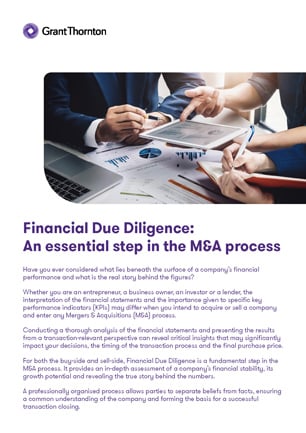-
Audit Industry, Services, Institutions
More security, more trust: Audit services for national and international business clients
-
Audit Financial Services
More security, more trust: Audit services for banks and other financial companies
-
Corporate Tax
National and international tax consulting and planning
-
Individual Tax
Individual Tax
-
Indirect Tax/VAT
Our services in the area of value-added tax
-
Transfer Pricing
Our transfer pricing services.
-
M&A Tax
Advice throughout the transaction and deal cycle
-
Tax Financial Services
Our tax services for financial service providers.
-
Advisory IT & Digitalisation
Generating security with IT.
-
Forensic Services
Nowadays, the investigation of criminal offences in companies increasingly involves digital data and entire IT systems.
-
Regulatory & Compliance Financial Services
Advisory services in financial market law and sustainable finance.
-
Mergers & Acquisitions / Transaction Services
Successfully handling transactions with good advice.
-
Legal Services
Experts in commercial law.
-
Trust Services
We are there for you.
-
Business Risk Services
Sustainable growth for your company.
-
IFRS Services
Die Rechnungslegung nach den International Financial Reporting Standards (IFRS) und die Finanzberichterstattung stehen ständig vor neuen Herausforderungen durch Gesetzgeber, Regulierungsbehörden und Gremien. Einige IFRS-Rechnungslegungsthemen sind so komplex, dass sie generell schwer zu handhaben sind.
-
Abacus
Grant Thornton Switzerland Liechtenstein has been an official sales partner of Abacus Business Software since 2020.
-
Accounting Services
We keep accounts for you.
-
Payroll Services
Leave your payroll accounting to us.
-
Real Estate Management
Leave the management of your real estate to us.
-
Apprentices
Career with an apprenticeship?!

What is a financial due diligence?
Financial due diligence (FDD) is a comprehensive evaluation of a business or individual’s financial condition, conducted prior to a sale, merger, or acquisition to ensure informed decision-making.
It involves a thorough review of financial data, including revenues, profitability, growth trends, required working capital, short- and long-term debts and their terms, income statements, balance sheets, and other pertinent details.
This process ensures a clear and accurate understanding of the target company’s financial position, uncovering hidden liabilities and validating the accuracy of financial statements.
By identifying potential risks, liabilities, or inaccuracies, FDD influences the terms and structure of the Sales and Purchase Agreement (SPA), enabling adjustments to the purchase price, inclusion of indemnities or warranties, and specific covenants to address uncovered risks.
FDD ultimately determines the success or failure of a transaction by offering a complete financial overview, which informs strategic decisions and safeguards stakeholder interests.
Financial due diligence vs. Audit
The approaches and analytical procedures of FDD and an audit may overlap. However, there are key differences between them. FDD is transaction-specific and strategic, while audits focus on compliance and regular assessment of financial accuracy. FDD is a recommended procedure during a transaction while an audit is often legally required if certain criteria are met.
Objective:
- FDD: Focuses on evaluating a company’s financial
condition, economic reality, going beyond accounting
standards and identifying potential risks, trends, and
opportunities to support strategic decisions during
transactions (e.g. mergers or acquisitions). - Audit: Ensures the accuracy and compliance of financial
statements with local (i.e. Swiss Code of Obligations, Swiss
GAAP FER) or international accounting standards (i.e. IFRS,
US GAAP).
Regulatory requirements:
- FDD: Not legally required; performed at the discretion of
the buyer or seller to gain deeper insights into the target’s
financial health or prepare for the transaction. - Audit: Mandated by law for certain types of companies,
based on size, revenue and structure.
Scope:
- FDD: Tailored to the specific needs of the client and
transaction and typically does not include control testing
unless otherwise agreed. It focuses on reviewing financial
trends, forecasts, and key metrics like profitability, growth
potential, quality of assets, working capital and debt. - Audit: Follows a standardized process, typically dictated
by laws or regulations, and usually focuses on verifying
historical financial data for one financial year, internal
controls, and statutory compliance.
Timing:
- FDD: A recommended procedure performed during a
transaction (e.g., pre-merger or acquisition) as a one-time
analysis to inform decision-making. - Audit: Conducted regularly (annually, semi-annually
or quarterly), often legally required, depending on the
company’s size and structure as part of the company’s
regulatory or statutory obligations.
Perspective:
- FDD: Both backward- and forward-looking, focusing on
current and future risks and opportunities. - Audit: Backward-looking, focused on historical financial
data and compliance.
Output:
- FDD: Provides insights and recommendations to inform
negotiations, including adjustments to purchase price or
SPA terms. - Audit: Issues an opinion on whether the financial
statements are free from material misstatements.
Buy-side vs. sell-side due diligence
From the buyer’s standpoint, engaging external advisors and M&A professionals to perform FDD is essential to verify the reliability of all financial information and key facts related to the transaction. This rigorous process plays a critical role in mitigating risks for the buyer.
While due diligence is often thought of from a buyer’s standpoint, the seller can also benefit from due diligence. For instance, the due diligence process may reveal that the fair market value of the seller’s company is higher or lower than initially anticipated and can impact the decision-making accordingly. In fact, before striking a potential deal, a seller may prepare its own due diligence report to support and streamline the buy-side diligence process, enabling a quicker path to closing the transaction and confirm the purchase price for the buyer.
Challenges and opportunities
Several challenges may arise during the FDD process, including the following:
- Limited access to information: The target company may be unwilling or unable to provide the due diligence team with all the necessary information, potentially hindering a comprehensive analysis.
- Incomplete or inaccurate information: Accessing reliable and complete financial information can be difficult, particularly if the target company has poor record-keeping or lacks transparency.
- Time constraints: FDD is often conducted within a tight timeframe, as it serves as the foundation for subsequent diligence activities. This urgency can make it difficult to thoroughly evaluate all potential risks and opportunities.
- Accounting standards and regulatory requirements: Navigating different accounting standards, tax regulations, and market practices across jurisdictions can complicate the process.
Despite these challenges, FDD also offers valuable opportunities, including the following:
- Risk identification and mitigation: FDD helps uncover hidden liabilities, financial risks, or operational inefficiencies, enabling informed decision-making and mitigating risks in the transaction.
- Identifying weaknesses in financial reporting: The process can uncover deficiencies in the target company’s financial reporting practices, offering the acquiring company an opportunity to implement improvements post-transaction.
- Enhancing strategic planning: Insights gained during due diligence can provide the acquiring company with a clearer understanding of the target’s financial health and functioning, enabling more informed decisions and improved financial planning.
- Uncovering synergy opportunities: A detailed analysis of the target’s financials may reveal areas where synergies can be achieved, contributing to improved profitability and post-transaction value.
- Understanding the key valuation parameters: This provides a clearer understanding of the target’s financial performance, leading to more accurate valuation and negotiation of purchase price.
- Improved deal structure and SPA terms: Equips buyers with data-driven insights to negotiate better terms and conditions for the deal by identifying areas for adjustments in transaction terms, such as warranties, indemnities, or payment structures, to safeguard the buyer's interests.
- Post-transaction planning and value creation: FDD findings can inform integration strategies and help identify priorities for immediate action after the deal closes and optimise future value creation.
Core aspects of a financial due diligence
The specific methods employed in FDD vary based on the size and complexity of the transaction and the industry in which the target company operates. Nonetheless, several standard procedures typically include:
Analyse Quality of Earnings and calculate sustainable EBITDA
The purchase price in many transactions is often determined as a multiple of the target company’s earnings before interest, taxes, depreciation, and amortisation (EBITDA). Consequently, a primary focus of FDD is to assess and validate the target company’s EBITDA. This process typically involves reviewing proposed adjustments from the target company and incorporating due diligence adjustments based on the findings of the due diligence team.
Calculate net working capital target
Transactions are frequently structured with the expectation that a normal level of net working capital (NWC) will be provided at closing. The due diligence team establishes an NWC target and identifies any debt-like items that should be excluded from the calculation.
Calculate net debt
Net debt is calculated by subtracting cash and cash equivalents from total interest-bearing liabilities or debt-like items identified during the FDD. The level of net debt directly impacts the target’s company value and requires thorough analysis by the due diligence team.
Management inquiries
The due diligence team conducts interviews with the target company’s management to gain deeper insights into the business and its financial reporting practices. These discussions often uncover topics such as accounting policies, estimates, and potential off-balance sheet liabilities.
Depending on the buyer’s requirements or industry-specific topics, the scope items and analytical procedures of FDD can differ since these are not predetermined by any regulatory or legal framework.
Conclusion
Financial due diligence is an essential element of the M&A process for both buyers and sellers.
On the buy-side, it helps to identify potential risks and opportunities while offering key insights into the target company’s financial health by reducing the information asymmetry to avoid overpaying.
On the sell-side, it supports and streamlines the buy-side diligence process, enabling a faster path to closing. By ensuring that due diligence is thorough and comprehensive, companies can significantly enhance their likelihood of completing successful M&A transactions.


